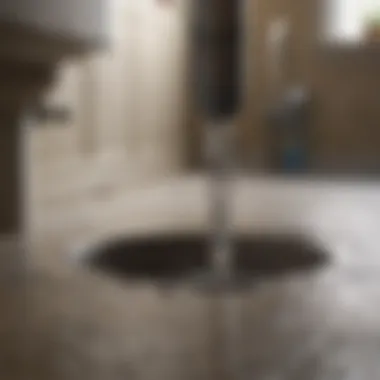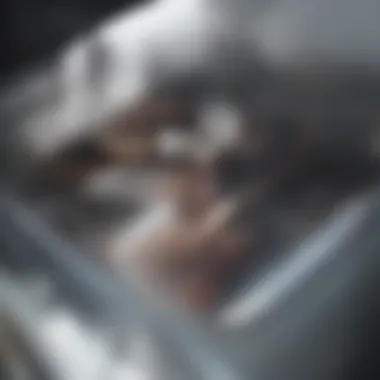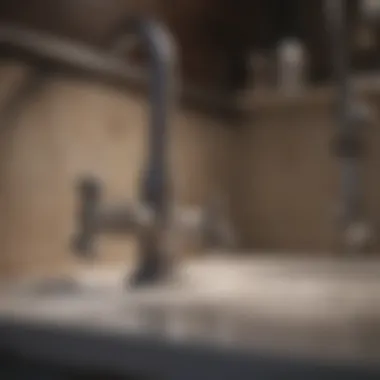Effective Steps to Unclog Your Drain with Garbage Disposal


Intro
Clogged drains are a common hassle in homes with garbage disposals, but understanding how to effectively deal with them is essential. This guide focuses on the intricacies involved in unclogging drains while leveraging the capabilities of a garbage disposal.
A garbage disposal is a useful kitchen tool, but it can become a source of frustration if not used properly or if it encounters clogs. Identifying the underlying issues that lead to these clogs can significantly improve plumbing maintenance and lower repair costs.
In this article, we will explore:
- Common causes of drain clogs
- The step-by-step process to unclog using a garbage disposal
- Preventive measures to minimize future clogs
- Troubleshooting techniques for more complex issues
Understanding these components will equip homeowners with the knowledge to manage and resolve drain issues efficiently.
Prolusion to Garbage Disposals
The role of garbage disposals in modern kitchens cannot be overstated. They have become essential appliances for many households. A well-functioning garbage disposal helps manage food waste effectively, reducing the likelihood of clogs in drains. In this article, we will take a closer look at garbage disposals, understanding their functioning, benefits, and some considerations regarding their use.
Understanding Garbage Disposals
A garbage disposal is an electrical device installed under a kitchen sink. It introduces the possibility of grinding food waste into tiny particles, which can easily flow through plumbing systems. Typically, these units consist of a motor and a grinding chamber. When food enters the chamber, it is subjected to the spinning blades that break it down. The ground waste is then flushed out through the drain with running water.
Benefits of Using a Garbage Disposal
Using a garbage disposal offers several advantages:
- Waste Reduction: One of the most significant benefits is that it minimizes the amount of waste sent to landfills. By grinding food scraps, households can reduce their overall waste footprint.
- Convenience: Garbage disposals make it easier to dispose of food waste quickly. Instead of collecting scraps for composting or throwing them away, you can simply push them down the drain.
- Odor Control: Properly functioning disposals help reduce the odors often associated with decaying food. This leads to a cleaner kitchen environment.
- Plumbing Protection: When used correctly, disposals can prevent clogs by breaking food scraps into manageable sizes. This, in turn, helps in maintaining smoother plumbing flow.
Causes of Drain Clogs with Garbage Disposals
Understanding the various causes of drain clogs when using garbage disposals is crucial for effective plumbing maintenance. Not only does recognizing these causes help in addressing issues quickly, but it also provides insights into how to prevent them. By knowing what leads to clogs, homeowners can make informed decisions about their disposal usage and avoid costly repairs.
Organic Matter Buildup
One of the primary contributors to drain clogs is organic matter buildup. Over time, food scraps and waste can accumulate in pipes and the disposal unit itself. This buildup occurs often when homeowners dispose of large quantities of fibrous or starchy foods, such as potatoes, celery, or corn husks. These materials do not break down easily and can form a thick sludge that clogs the system. Additionally, grease and oil can congeal and trap food particles, compounding the problem.
To mitigate organic matter buildup, it is important to understand what can and cannot be placed in the disposal. Food waste should be processed in small amounts while maintaining a steady flow of water. This approach keeps food particles moving through the system, reducing the chance of a clog.
Foreign Objects
Foreign objects are another significant cause of drain clogs that homeowners often overlook. Items such as utensils, rubber items, and non-food materials can easily find their way into the disposal. When these objects get caught in the blades, they can create a blockage that prevents waste from passing through effectively. Furthermore, hard objects like bones or fruit pits can damage the disposal unit, leading to more complicated repairs.
To avoid issues related to foreign objects, homeowners should maintain diligence about what goes into the disposal. Establishing a clear guideline can help in preventing these costly mishaps, thus ensuring the disposal remains in good working order.


Insufficient Water Flow
Insufficient water flow during the disposal process can lead to clogs as well. Water is essential for helping food particles move through the disposal and into the plumbing system. If there is not enough water, food waste may not properly disintegrate, leading to stagnation and eventual blockage.
Homeowners should run water continuously when using the disposal. It is generally recommended to allow the water to flow for several seconds after the disposal stops to ensure that all food waste has cleared the pipes. This practice fosters healthy drainage habits and contributes to the longevity of the disposal unit.
Maintaining clarity regarding the causes of clogs can prevent frustrating situations and costly repairs.
By being mindful of how a garbage disposal is used, issues related to organic matter buildup, foreign objects, and insufficient water flow can largely be avoided. Taking these preventive measures enables homeowners to enjoy an efficient and functional plumbing system.
Initial Steps Before Unclogging
Before you delve into the process of unclogging a drain with a garbage disposal, it is crucial to approach the task methodically. Understanding and addressing initial steps can significantly influence the effectiveness of your efforts and ensure safety throughout the procedure. Taking time to prepare can prevent mistakes that might worsen the situation or lead to injury. Considering both the safety and the required tools are essential components of these initial preparations.
Safety Precautions
When it comes to unclogging drains, safety should be a top priority. The garbage disposal can present various risks if appropriate precautions are not observed. Here are some key safety measures:
- Turn Off the Power: Always ensure that the garbage disposal is unplugged or the circuit breaker is switched off. This prevents accidental activation while you work.
- Wear Protective Gear: Using gloves is advisable as you may handle sharp or unpleasant objects. Safety goggles can protect your eyes from debris and potential splashes.
- Be Careful with Tools: Ensure that all tools you use are in good condition. Broken or faulty tools can lead to accidents.
- Avoid Using Hands: Never insert your hands into the disposal unit unless the power is completely off. This can significantly decrease the risk of injury.
By adopting these precautions, you reduce the likelihood of accidents and prepare for a more efficient unclogging process.
Tools Required
Equipping yourself with the right tools is vital for an effective unclogging process. The right tools not only aid in removing clogs but also enhance safety and efficiency. Here are some tools to consider having on hand:
- Plunger: A standard toilet or kitchen plunger can create suction, helping dislodge minor clogs.
- Wrench: A wrench may be needed to loosen or tighten connections, depending on the situation.
- Flashlight: Good visibility is important in examining the disposal and drain, especially in tight spaces.
- Auger: A plumber's snake can help clear deeper blockages that a plunger might not reach.
- Bucket: A bucket is useful for catching water or debris that may spill when you disconnect a trap or disposal.
By ensuring you have these tools, you set a foundation for a smoother unclogging process. This preparation minimizes interruptions and enhances the speed at which you can address the problem.
Step-by-Step Process to Unclog a Drain
The process of unclogging a drain with a garbage disposal often requires systematic actions. By following a detailed approach, homeowners can alleviate potential headaches caused by clogged drains. This section walks you through essential steps, helping to ensure the task is handled safely and effectively. Not only does this methodical process address the immediate issue, but it also provides insights into maintaining the system in the long run, helping to prevent the recurrence of the problem.
Turning Off the Power
Before engaging in any plumbing task, safety must come first. Turning off the power to the garbage disposal prevents any accidental activations during the unclogging process. This can be done by locating the disposer's power switch, usually found under the sink or on the wall nearby. Alternatively, unplugging the unit directly from the electrical outlet is a safe measure. Always ensure the disposal is completely off to avoid injuries or further damage.
Inspecting the Garbage Disposal
After ensuring the system is powered down, proceed to inspect the garbage disposal for any visible signs of obstructions. Using a flashlight can help in examining hard-to-see areas. Look for any food particles that may have accumulated near the blades or drainage path. It is advisable to not put your hands in the disposal unit until you confirm it is safe. Understanding what you are looking for can guide you in taking the right steps next.
Using a Plunger


If inspection reveals that the disposal is clogged, it may be time to utilize a plunger. Choose a plunger with a flat bottom, which is effective for creating a seal over the drain. Fill the sink with some water to immerse the rubber part of the plunger. Then, perform a series of firm up-and-down motions. This action can help to dislodge minor blockages in the pipe system. If the clog is stubborn, repeat this process several times until the drain clears.
Clearing the Drain Trap
In some cases, the issue may not lie within the disposal itself but rather in the drain trap, which is located beneath the sink. To clear it, have a bucket ready to catch any residual water that may spill. Begin by loosening the slip nuts on the trap. Carefully remove it from the pipes, allowing any trapped debris to empty into the bucket. Clean the trap thoroughly, removing any buildup before reattaching it. This can significantly enhance water flow and flush out persistent clogs.
Resetting the Garbage Disposal
After completing the above steps, it is essential to reset the garbage disposal. Most disposal units have a reset button located at the bottom or side. Press this button to restore power to the unit. Depending on the model, you might also need to restore the power supply at the wall outlet. This action allows the device to restart and function normally after addressing any clogs or issues.
Regularly performing these steps can significantly extend the lifespan of your garbage disposal and reduce instances of clogging.
By adhering to these steps and being mindful of the overall maintenance, you will ensure your sink remains functional and hassle-free.
Preventive Measures Against Clogs
Preventive measures are essential when dealing with the frequent problems of clogged drains, especially when using a garbage disposal. Understanding these measures not only helps avoid inconveniences but also extends the life of your plumbing system. It is important to be proactive rather than reactive. Taking the right steps reduces the likelihood of clogs, saving both time and money.
Proper Usage Guidelines
Using a garbage disposal properly is key to preventing clogs. Incorrect use can result in unnecessary strain on the device and the plumbing.
Here are some guidelines to follow:
- Scrape food waste into the disposal instead of rinsing down large scraps with water. This helps prevent buildup in the pipes.
- Always run cold water before, during, and after operation. Cold water helps solidify any grease or fats that might be present, allowing them to be ground up efficiently.
- Avoid fibrous or starchy foods. Items like celery, onion skins, potato peels, and pasta can wrap around disposal blades and cause blockages.
- Limit the disposal's load. Do not overload the unit with too much food waste at once. This can overwhelm the system, leading to clogs.
- Don't put non-food items in the disposal. Items like plastic, paper, and metal can damage the blades and cause severe blockages.
By adhering to these usage guidelines, homeowners can lessen the chance of clogging, ensuring the garbage disposal functions optimally.
Regular Maintenance Tips
Regular maintenance of your garbage disposal and associated plumbing is vital for smooth operation. Consistent care can significantly lessen the combative scenarios of clogs.
Consider the following maintenance tips:
- Run the disposal regularly. Even if you do not have waste to process, running the disposal with cold water keeps the blades moving and clear of buildup.
- Clean the disposal monthly. Grinding ice cubes, citrus peels, or baking soda can help eliminate odors and clean the internal components.
- Inspect the splash guard. Check and replace it if necessary to prevent food particles from escaping into the sink.
- Schedule professional checkups. Consider having a plumber inspect the disposal periodically to ensure everything is functioning optimally, catching potential issues early.
Proper maintenance leads to longevity of your disposal system and helps maintain a clean, efficient environment in your kitchen.
By integrating these preventive measures into your routine, clogs can be largely avoided. Awareness of proper usage and regular maintenance defines effective management of garbage disposals. This proactive approach ensures a hassle-free experience when it comes to handling drains.
Troubleshooting Common Issues
Understanding how to troubleshoot common issues with garbage disposals is an essential part of maintaining a well-functioning kitchen. These appliances can face a range of problems, from failure to start, unpleasant odors, to noise and vibration. Knowledge of these issues not only helps in identifying the root cause quickly but also saves time and avoids unnecessary service calls. Each subsection below explores specific problems and offers practical solutions that can restore proper operation.


Disposal Won't Start
When a garbage disposal won't start, it can be frustrating. The first step is to check if it is plugged in. Sometimes, the simplest solution is overlooked. Ensure that the power cord is securely connected to the outlet. If it’s plugged in and still does not work, an overloaded circuit might be the issue. In some cases, a reset button located on the bottom or side of the disposal needs to be pressed. If the unit hums without grinding, the blades might be jammed. It is necessary to turn off the power and manually free any obstruction found. Lastly, if none of these steps resolve the issue, it could signal a more serious electrical problem requiring professional assistance.
Unpleasant Odors
Unpleasant odors emanating from a garbage disposal can indicate food residues trapped within. Regular cleaning is vital to avoid this. A simple solution involves placing ice cubes and citrus peels into the disposal. Run cold water and turn on the disposal to break down stubborn debris while adding a fresh scent. Should odors persist, consider inspecting the splash guard and drain for hidden food particles that may not be easily removed. Using a mixture of vinegar and baking soda can also help eliminate smells. Pour some vinegar down the drain, followed by baking soda. Allow the mixture to sit for a few minutes before flushing it with hot water.
Noise and Vibration Problems
Noise and vibration problems often arise from loose components or jammed parts within the disposal. If the disposal is making unusual sounds, turn it off immediately to prevent further damage. Check for any obstructions inside. Typically, objects like utensils or large pieces of food can cause jams. After clearing any blockages, tighten screws or clamps that may have loosened over time. \n Moreover, excessive vibrations can indicate installation issues. Ensure the disposal is mounted securely under the sink. In some cases, adding rubber pads or adjusting the positioning can help in minimizing noise and vibration. If the issue persists, it may be prudent to consult the manufacturer’s recommendations or seek professional advice.
Troubleshooting your garbage disposal issues can prevent a minor setback from escalating into a major repair, ensuring your kitchen remains efficient.
When to Call a Professional
Dealing with clogged drains can sometimes lead to complicated issues that require specialized knowledge. Homeowners should be mindful of the limitations of their own skills and resources when tackling these plumbing challenges. Engaging a professional can prevent potential further damage, leading to a more cost-effective solution in the long run. Knowing when to seek help is vital for proper home maintenance and to avoid stress.
Identifying Serious Issues
When faced with persistent drainage issues, it can be difficult to determine whether the situation warrants calling a professional. Some indicators include:
- Repeated Clogs: If a drain regularly becomes clogged despite your efforts to clear it, there may be an underlying issue that needs inspection.
- Water Backup: If water begins to back up into other drains or fixtures, it often suggests a larger problem within the plumbing system.
- Unusual Sounds: Any strange noises from the garbage disposal or plumbing can sometimes signal an obstruction that might not be easily accessible.
- Bad Odors: Foul smells could indicate decomposing food or stagnant water, prompting the need for expert assistance.
Ignoring these signs can lead to more extensive and costly repairs. Professionals can provide a thorough diagnosis and fix complicated problems, such as blockages deep within the pipes or issues with the plumbing layout.
Cost Considerations for Professional Help
Cost is always a concern when deciding whether to hire someone for home repairs. Here are some key points to consider regarding hiring a professional plumber:
- Service Fees: Most plumbing services have a base fee that covers the diagnosis of the issue. This can vary depending on the complexity of the job and the plumber's experience.
- Potential Savings: Although hiring someone incurs an upfront cost, it may save on future repairs. Attempting to fix major issues yourself can sometimes result in aggravated problems and higher repair costs.
- Time Efficiency: Professionals can often identify and resolve issues more quickly than an untrained person. They have access to the right tools and equipment, which can save you time.
- Quality Assurance: Most plumbing services offer some warranty on their work, providing peace of mind that the issue has been effectively resolved.
In summary, when facing persistent issues with your garbage disposal and drains, carefully weigh the benefits of hiring a professional. It often ensures a thorough and efficient resolution, mitigating further complications down the line.
The End
In this article, we explored the various methods and considerations for unclogging drains that utilize garbage disposals. Understanding how to effectively manage clogs is crucial for homeowners. Not only does it prevent disruption in daily routines, it also helps maintain the efficiency of the garbage disposal itself.
Summary of Key Points
- Causes of Clogs: Recognizing the most common sources of drain clogs, such as organic matter or foreign objects, is the first step towards effective maintenance.
- Initial Steps: Safety must always be prioritized. Turning off power and gathering necessary tools is essential before tackling the issue.
- Step-by-Step Process: A structured approach, beginning with power off, inspecting the disposal, plunging if necessary, clearing the drain trap, and finally resetting the system can lead to successful unclogging.
- Preventive Measures: Regular checks and mindful disposal of waste can significantly minimize potential clogged drains.
- When to Seek Help: It is important to identify when an issue is beyond a DIY fix. Engaging a professional may be wise for complicated problems.
Final Thoughts on Drain Maintenance
Ongoing drain maintenance is a responsibility that safeguards the entire plumbing system. Adopting proactive habits, such as adhering to proper usage guidelines and performing regular maintenance checks, plays a crucial role. If a drain is persistently clogged or problems keep recurring, do not hesitate to consult resources or seek professional help.
"Regular drain maintenance not only saves time and money but preserves the longevity of your garbage disposal."
By keeping these considerations in mind, homeowners can avoid unnecessary plumbing stress and keep their kitchens running smoothly.







